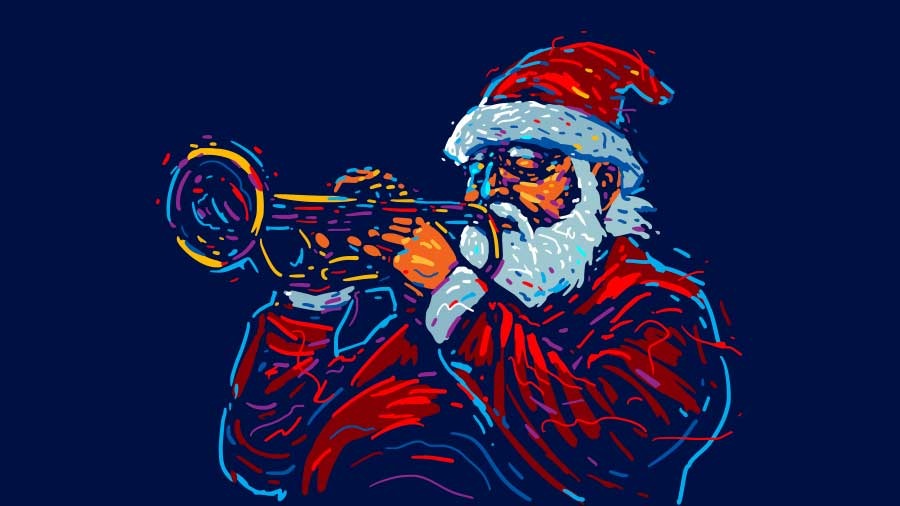Feliz Navidad. Arguably the most popular Christmas song. It doesn’t matter that most cannot decode some of the words but what I do know is that as soon as the singer comes to “I want to wish you a Merry Christmas and a Happy New Year” at 12 hours and 13 seconds at the Tolly Club, each one makes an impromptu leap into the arms of the other and pretends that a big moment has arrived… when in reality the big moment is seven nights away.
Santa Claus is coming to town. The lead up words are an evergreen turn on: “You’d better watch out. You’d better not cry. You’d better not pout. I am telling you why… Santa Claus is cominggggggg… to town.” The song is not just about Christmas; it is about all of us and the expectation of better times. I can almost hear Sumit Roy singing this in the Sarobar (before the NGT shut our shows down).
Rudolph the red-nosed reindeer. There is a nice animation on YouTube that describes how the Christmas festivity is to be cancelled on account of the murky weather, until the intending Santa (in mufti) espies Rudolph and decides on the spur of the moment that this reindeer with a red shining nose — an unusuality — will show his sleigh the way.
Jingle bells. It is amazing how this kiddy stuff can get adults nostalgic and dancing. During our Rabindra Sarobar Christmas concerts, this song — the most elementary in the batting order of Christmas songs — would get geriatrics across both genders to the dance ‘floor’ (in this case, the bitumen of the Sarobar) with the words “Chol!”. The beat possibly had something to do with it.
Silent night, holy night. There can’t be a Christmas without this simply because no other number evokes the ‘maahaul’ of when Jesus was born — the innocence, the wonder and the divinity. Besides, possibly no other song can be sung by all (children, asthmatics and infirm, if you know what I mean). Completes the environment at churches and schools across the city. I can visualise the choir singing this in the cathedral stillness on December 24th — the kind of performance and ambience that makes non-Christians like me say: “Can’t miss Midnight Mass at St Paul’s”.
Strangers in the Night. One of the first persons I heard singing this was Neil O’Brien until I realised that there was someone called F. Sinatra from Hoboken who had made it popular. Neil sang this at virtually every wedding or gathering where the mike was passed to him. He would do so at the New Year’s Eve party at Dalhousie Institute when the crooners would have disappeared to lubricate their tonsils and the active dancers had turned to chairs and handkerchiefs. I will not exaggerate O’Brien’s baritone; Sinatra was better… but only by a few notches.
When the saints go marching in. The kind of song at Tolly or CCFC Christmas or New Year’s when the young nephew dashes off the dance floor to drag his older kith or kin to the ‘ring’ for a feel-good shake where elbows threaten ribs, shoulders shove shoulders and the jealous boyfriend steps in with a sentence of caution. Blame Shayne Hyrapiet.
Besame mucho. Written in 1940 (by Mexican Consuelo Velazquez). There is the Usha Uthup version. There is the Cuban street singer version. There are hazaar versions. Don’t understand a word of the song. But then you don’t need to understand to understand. If they haven’t performed this towards the later part of the night, then it says something about the singer or DJ.
Last Christmas. The words of the first stanza: “Last Christmas I gave you my heart/ But the very next day you just gave it away. This year to save me from tears, I’ll give it to someone special.” The jury is still out on whether this Wham! number captures the Christmas mood, but the very mention of the C word facilitates its wild card entry into every December 24 performance.
By the rivers of Babylon. What’s the connection with Christmas? No clue. Maybe the word ‘Babylon’. Maybe the beat of the song. Maybe that it serves as a fitting dance number. When one is swinging, one doesn’t quite walk up to the DJ to ask. As long as the floor is dancing one doesn’t care.

